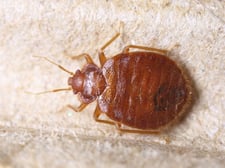Bed Bug Removal & Treatment in Dallas
Bed Bug Control

Bed bugs feed on blood and also spread diseases to animals. Many people are allergic to bed bug bites. These pests hide in furniture, luggage, backpacks, purses, or upholstered surfaces. Here are some of the basic approaches for identifying bedbug bites and infestations and controlling them.
How to Identify Bed Bug Bites
Bed bugs are nourished by blood. To mature into adults, these pests need to feed at least once during each immature stage. Fully grown termites need blood to produce eggs.
To identify bed bug bites, start by looking for blood spots on your sheets. Bites are mainly found on parts of your body that are exposed to the pests during sleep - the face, neck, hands, and arms. In most cases, the bites are grouped together in one small area or sometimes in a zigzag pattern. Bites are itchy, red, inflamed, or blistered. Bite reactions take a few days before they appear.
How to Identify Bed Bug Infestation
Bed bugs like to hide in bed frames, mattresses, bedding, carpets, furniture, bedroom clutter, and baseboards. You will mostly find them in the seams of your mattress or in box springs. Locating a specimen is not the only way of identifying an infestation. The excrement of these pests leaves black or brown stains on linens and mattresses. Bloodstains may also be seen on spots where the pests have been crushed.
The presence of one female bed bug is an infestation about to happen. A healthy female pest can produce up to 500 healthy eggs and can lay up to 5 eggs daily. Therefore, spotting one healthy female bed bug is a potential sign of a bed bug infestation unless a pest management service intervenes immediately.
How to Get Rid of Bed Bugs
Reduce Clutter
Get rid of all personal items that are not stored in the room permanently. Note that items in the infested area can easily transfer the pests to other areas. It is advisable to bag these items in plastic bags.
Launder Infested Linens and Garments
You cannot treat bed linen and infested garments with insecticide. The best approach is to launder these garments in hot water. Another alternative is to heat the bed linens or garments for a few minutes in a dryer.
Dismantle Bed Frames
You can easily expose the hiding sites of pests by dismantling bed frames. Try as much as possible to reach for these areas when cleaning. Use a flashlight to peer through the gauze fabric of your bed. If the fabric has been torn, then it is possible that bed bugs are hiding at this spot. Remove the gauze fabric and spray the spot. If the box springs and mattress are infested, it might be better to consider using encasement's. When the mattress is covered with an encasement, the bed bugs can neither enter nor leave. When using encasement's, there is no need to spray the mattress.
Remove Dresser Drawers
Bed bugs also like hiding in desks and dressers. Remove drawers from dressers and desks and inspect the possible hiding spots. Pull all the furniture from the wall and clean all the hiding spots.
Clean the Area
Clean infested areas using a stiff brush to remove eggs. Vacuum clean the room thoroughly. Vacuum the crevices and cracks on furniture and along the baseboards on the walls. Also, vacuum along the furniture, baseboards, rails, bed stands, and foot boards, headboards, and tufts, edges of the bedding, buttons, and the edges of your carpets. A good cleaning job will get rid of particles from the crevices and cracks and facilitate better insecticide penetration. Bed bugs can stick tightly to surfaces. It is advisable to clean by using the end of the vacuum cleaner over the affected area to remove the bed bugs. Try not to use the bristle attachment because you risk transferring the pests to other areas. Dispose of the vacuum cleaner bags after cleaning.
Caulk and Seal
Caulk and seal the holes where wires and pipes penetrate the floor, walls, and fill cracks around molding and baseboards to reduce the harboring spots.
Use Pesticides
In some cases, pesticides can come in handy when controlling pests in your home. However, you should abide by the following rules when using chemical treatments insecticides:
- Use pesticides registered by the U.S. Environment Protection Agency. Check for the U.S. EPA registration number on the label of the pesticide. Ensure the label includes bed bug control.
- Don’t apply pesticides on your body
- Only use authorized products for bed bug treatments
Don’t use outdoor pesticides in your home
In case you opt to contract a pest control company, ensure they are experienced and licensed. The ideal pest control service should be registered by the Department of Environmental Conservation and follow the recommended standards for pesticide application.
Wrapping Up
Identifying bed bugs is quite a laborious exercise; it is even more difficult to control a fully-blown infestation. Learning how to spot bed bug bites and bed bug infestation can help you identify the best approach for bed bug control. The following pointers can help you deal with pests before they become a problem. If the infestation is serious, it is advisable to hire an experienced and licensed pest control service. Call SafeHaven Pest Control Now



